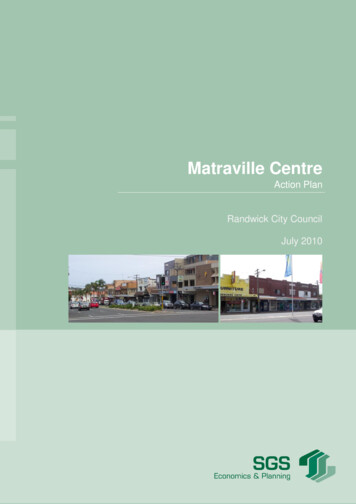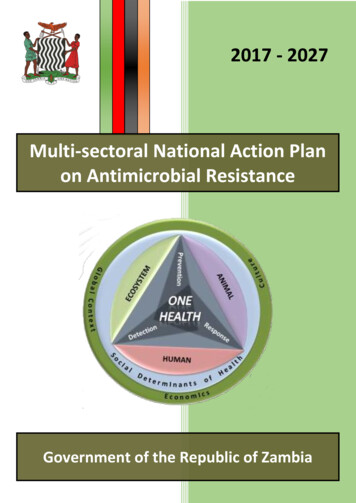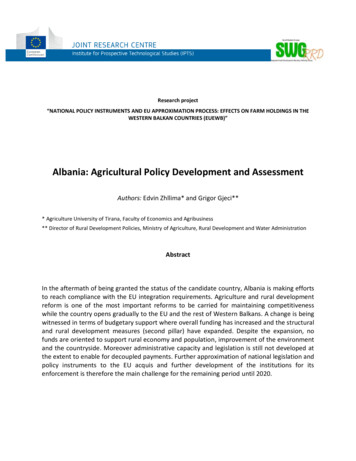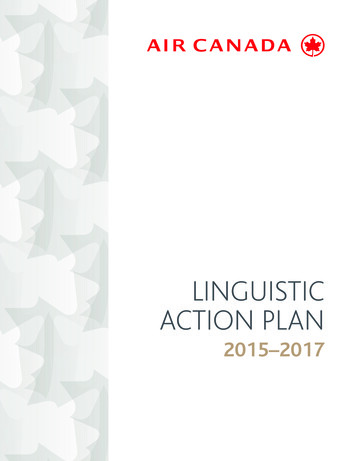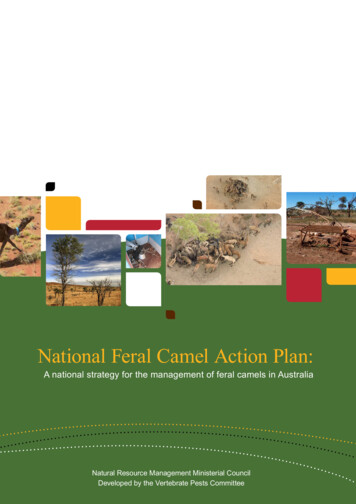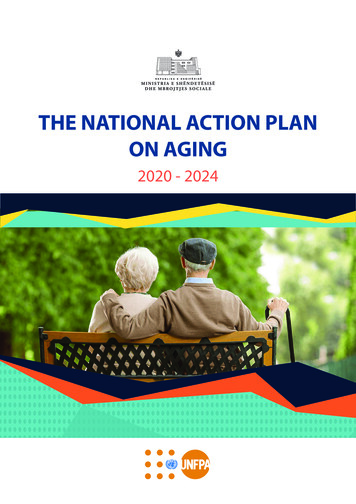
Transcription
THE NATIONAL ACTION PLANON AGING2020 - 2024
The drafting and publication of the National Action Plan on Aging were made possible by the United Nations Population Fund (UNFPA) and were coordinated by the Albanian Center for Population and Development (ACPD).Scanderbeg Street, UN House, 2nd floor, 1000 Tirana, Albaniaweb: albania.unfpa.orgTelephone: 355-4-4500015/6/7QENDRA SHQIPTARE PER POPULLSINE DHE ZHVILLIMINALBANIAN CENTER FOR POPULATION AND DEVELOPMENT26 Gjergj Fishta Boulevard, Entrance No. 6, Apt. No. 5, 1001, Tirana, AlbaniaEmail: info@acpd.org.al web: http://acpd.org.alTelephone: 355 4 2251 4752THE NATIONAL ACTION PLAN ON AGING 2020-2024
THE NATIONAL ACTION PLAN ON AGING2020-2024DECISIONNO. 864, of 24.12.2019ON THE ADOPTION OF THE 2020-2024 NATIONAL POLICY DOCUMENT ON AGINGAND THE NATIONAL ACTION PLAN FOR ITS IMPLEMENTATIONPursuant to Article 100 of the Constitution, upon a proposal by the Minister of Health and Social Protection, the Council of MinistersDECIDED:1. To adopt the 2020-2024 national policy document on aging and the national action plan for its implementation,in accordance with the text that is attached to this decision.2. The Ministry of Health and Social Protection and its subordinate institutions, the Ministry of Finance and Economyand its subordinate institutions, the Ministry of Education, Sports and Youth, the Ministry of Interior and local government units are tasked with the implementation of this decision.Ky vendim hyn në fuqi pas botimit në Fletoren Zyrtare.PRIME MINISTEREdi RamaNATIONAL POLICY DOCUMENTON AGING2020–2024December 2019THE NATIONAL ACTION PLAN ON AGING 2020-20243
4THE NATIONAL ACTION PLAN ON AGING 2020-2024
A message by H.E. Ogerta Manastirliu,Minister of Health and Social Protection of Albania1 October 2019, International Day of Older PersonsThe 2020-2024 National Action Plan on Aging comes in response to the social and demographic challenge of aging ina period of major demographic transformation like no others in the history of Albania. During this time, the numberof elderly persons has increased several folds, while the number of children and young people has decreased remarkably, as a result of both declining birth rates and emigration. There is, therefore, an increasing number of persons whocan and must continue to take an active part in society after retirement, too.This speedy demographic transition the country has experienced, has been accompanied by both a decrease in thesize of family units and an ever-declining tradition of supporting the elderly. In addition, unlike most of the countriesin the region, Albania has not inherited a traditional and integrated system of social and health care for the elderly.The goal of this Policy Document is to ensure that elderly persons are integrated better in society, they are providedwith quality services, and that they enjoy a long, healthy and productive life. Albania’s Aging Plan is in line with theconclusions of the European Union for Life-Long Healthy Aging. It is the EU’s Third Health Programme that identifiesdemographic changes as the key challenge for our region.Through the implementation of this Plan, the Albanian Government aims at achieving one additional year of healthylife expectancy in the country, the halving of poverty in over-65-year-olds and full coverage of health and social careservices for the elderly persons that need them.During the implementation, we will improve pensions and access to public transport for thousands of vulnerableelderly persons. Thousands of others will gain from the use of the new day centres and social activities co-organisedby the government and the municipalities. There will also be more housing opportunities and residential centres forthe elderly with special needs. In addition, tens of thousands of elderly persons will have new opportunities for betterquality and integrated social and health care services.Last but not least, so as to meet the letter of the Plan in spirit, by the end of the five-year implementation period, ourwhole society will be more aware of, and ready and willing for an Albania of all ages.THE NATIONAL ACTION PLAN ON AGING 2020-20245
CONTENTS1.2.PART I: POLITICAL, INSTITUTIONAL AND SOCIAL CONTEXT1.1.Demographic Analysis101.2.A brief summary of the economic conditions and health and social situation of the elderly111.3.The legal framework protecting the rights of elderly persons131.4.Responsible institutions for policies on the elderly141.5.Aging rights/The challenges of the 2020-2024 National Action Plan14PART II: AGING POLICIES AND STRATEGIES162.1.Drafting the National Action Plan and the methodology used16References to other national and international strategic documents and theSustainable Development Goals17The vision, principles and general aims of the Action Plan172.3.1. The principles upon which the document is based182.3.2. The vision182.3.3. General aims182.3.4. Impact indicators182.2.2.3.3.69PART III: POLICY AIMS AND SPECIFIC OBJECTIVES OF THE STRATEGY193.1. Pimary aging policies, 2020-2024193.2. POLICY 1: PROTECTION AND SOCIAL INCLUSION FOR THE ELDERLY193.2.1. Specific objective 1 of the aim of policy 1203.2.2. Specific objective 2 of the aim of policy 1203.2.3. Specific objective 3 of the aim of policy 1203.2.4. Specific objective 4 of the aim of policy 1213.2.5. Specific objective 5 of the aim of policy 121THE NATIONAL ACTION PLAN ON AGING 2020-2024
3.3.POLICY 2: INTEGRATED SOCIAL AND HEALTH SERVICES THAT ARE SUITABLE FOR THE ELDERLY223.3.1. Specific objective 1 of the aim of policy 2223.3.2. Specific objective 2 of the aim of policy 2233.3.3. Specific objective 3 of the aim of policy 2243.3.4. Specific objective 4 of the aim of policy 2243.4.POLICY 3: PROMOTING HEALTH AND WELFARE FOR THE ELDERLY; RAISING THE AWARENESSOF SOCIETY ON AGING.253.4.1. Specific objective 1 of the aim of policy 3263.4.2. Specific objective 2 of the aim of policy 3263.4.3. Specific objective 3 of the aim of policy 3274.PART IV: MONITORING AND ACCOUNTABILITY28REFERENCES49THE NATIONAL ACTION PLAN ON AGING 2020-20247
8THE NATIONAL ACTION PLAN ON AGING 2020-2024
1PJESA I: KONTEKSTI POLITIK, INSTITUCIONAL DHE SOCIALPART I: POLITICAL, INSTITUTIONAL ANDSOCIAL CONTEXTAlbania is experiencing the effects of aging after a period of unprecedented demographic transformation, a periodin which the number of elderly persons has increased several folds, while the number of children and young peoplehas decreased, as a result of both declining birth rates and emigration. This speedy demographic transition has beenaccompanied by a decreasing size of the families and its traditional role in supporting the elderly. In addition, unlikemost of the countries in the region, Albania has not inherited a traditional and integrated system of social and healthcare for the elderly.The Policy Document of Social Inclusion (PDSI) 2016-2020, adopted by Council of Ministers’ Decision No. 87, of03.02.2016, an extremely important document of the Albanian Government, guarantees a contemporary and responsible system for the evaluation of social inclusion in various sector policies, such as social protection, employmentand skills enhancement, health, education, housing and fulfilment of basic needs, social participation policies and therespect for human rights. This Policy Document aims at creating a protective and reintegrating environment for themost excluded groups of Albanian society, including the elderly.Matters pertaining to the creation of this protective environment for individuals in need, have been gradually included in the list of priorities for the Albanian Government during this past decade. The social protection of groupsin need has changed from the recognition of their rights to respecting and guaranteeing these rights. Nonetheless,Albania’s poor heritage and socio-economic challenges have been the factors that have determined the direction thatsocial policies have taken through the course of the years. It is due to the country’s social and economic conditionsand other transition-related phenomena that excluded individuals and/or groups in need are faced with rather criticalsituations that have a direct bearing on the denial of their rights, their exclusion or failure to respect these very rights.It is in this context that the Ministry of Health and Social Protection (MHSP) prepared the National Action Plan on Aging, as the competent authority for protection and social inclusion policies, with the support of the UNFPA and otherstakeholders.There are around 400,000 elderly persons in Albania, making up 14% of the total population of the country. Around60% live in isolated areas. Living alone or in poverty, facing several barriers such as special health conditions or poorinfrastructure of service provision are some of the factors that impede the full and effective participation of the elderlyin society1.It is worth stating that the social services system has improved considerably in terms of public access, mainly due tothe effective cooperation of state structures with NGOs. It is thanks to this cooperation that many community-basedservices are supporting individuals and families in need. Nevertheless, of all of the services provided, the most criticalfor the elderly are health and social services.Further to Territorial Administrative Reform, local government units have been granted more competencies in termsof providing social welfare services and making sure they are both available and working. However, the increasedcompetencies need to be accompanied by additional human and financial resources, as this will ensure the provisionof good quality services and effective social welfare. Municipalities have been involved in the preparation of socialplans, including the needs of and services for the elderly, which will be part of the financial mechanism of the socialfund.Present efforts have identified the most fundamental problems both the elderly and excluded groups are with. It wasfor the purpose of harmonising policies, coordinating efforts and increasing the effectiveness of existing resourcesthat the need for the drafting of the Action Plan arose in the first place.1Assessing the social, economic and health situation of elderly persons in Albania and their participation in society, the Albanian Aging Network,October 2017.THE NATIONAL ACTION PLAN ON AGING 2020-20249
1.1. Demographic AnalysisOver the years, the population structure may change significantly as a result of the interaction of the demographicprocesses, such as the birth rate, death rate or migration, and other indirect factors, such as the choices of lifestyle orthe offering and efficiency of healthcare services.The population of Albania, as of January 1st, 2019 numbered 2.862,427 inhabitants by suffering a decrease of 0.3 percent compared with the figures of January 1st, 20182. The demographic transition in Albania has visibly culminatedinto a gradual “ageing” of the population over the last decades. Therefore, the number of elderly constitutes over 11per cent of the general population of our country with an upward trend in the coming years3.Albania is feeling the effects of the ageing of the population – a process according to which the elderly have a proportionally higher percentage of the whole number of the population. In the last two decades, a specific demographictransformation took place: an increase of the percentage of the elderly 65 years of age and above that is accompaniedwith a decrease of the percentage of children and young people4. This situation is amplified even more by the higherlevels of emigration of the young people and middle-aged individuals, which makes it necessary to treat the issues ofthe ageing of population amongst the main priorities of the Albanian Government.The continuous and widespread emigration accompanied by lower birth and death rates has had a very big influence in the structure of the population of Albania. The number of persons within the 15-64 years of age group hasremained quite sustained in the period between the last two censuses, by falling from 1.96 million in 1989 to 1.90million in 2011. On the other hand, for a population that is generally speaking suffering a contraction there is a sharpincrease of the number of elderly persons of 65 years and above that goes from 169 thousand to 318 thousand for thesame period5. This is a clear indication of the complete transformation of society in only 22 years.According to updated projections, the population of Albania by 2031 is calculated to be 2,745.996 inhabitants. Thisnumber is almost 36 thousand inhabitants less when compared to the number of population for the PopulationProjections 2011-2031. The difference in this number is a direct consequence of the low birth rates and the genderdistribution of emigrants, that does not correspond with the Population Projections’ hypothesis for 2011-2031.6The growth at slow rates of the Index of Synthetic Fertility (ISF), accompanied by the coming of a reproduction ageof generations of women fewer than the current ones will make it possible for the number of births not to sustainsignificant changes from 2019 through 2031. At the same time, the number of deaths will continue to increase, as aresult of a population who is largely composed of the elderly. These two changes will also bring about the decline ofthe natural additive of up to 3.2 thousand in 2031.An important aspect of the ageing process is the progressive demographic ageing of the older population itself. Anincreased number of the elderly who are older is a direct result of the increased longevity, that has been noticed inthe previous decades and that is thought to continue in the future decades. It is a different matter if the extra yearsgained through longevity are lived in good or bad health.In the past, marriage was a universal thing for the population of Albania and remarriage, especially noticed in men,was quite common. The current analysis shows a postponement of marriage, a decrease of the remarriage rates andalso there are trends of its abandonment. Currently, the low level of marriages is reflected by an increased level ofdivorces7. Demographers have described the development from the higher regimes of birth and death rates to lowerregimes of birth and death rates as a “demographic transition”.Although Albania has completed its First Demographic Transition in the decade before the 2011 census, the sameperiod shows trends that may be interpreted as the first steps of a Second Demographic Transition.102INSTAT, Population of Albania, January 1st, 20193MOSHA (Movement of Organizations Supporting Healthy Ageing), SUMMARY OF THE STUDY WITH THE ELDERLY IN ALBANIA, 20174Ageing of Population: The situation of the elderly in Albania, November 20155Ageing of Population: The situation of the elderly in Albania, November 20156INSTAT, Projection of Population 2019-20317Albania: Population and its Dynamics – New Demographic Horizons, INSTAT, May, 2014THE NATIONAL ACTION PLAN ON AGING 2020-2024
PJESA I: KONTEKSTI POLITIK, INSTITUCIONAL DHE SOCIAL1.2. A brief description of the economic, health and social conditionsof the elderlyThe influence of poverty and other social issues of the Albanian society, described above, together with the “age barriers”, the health conditions or the poor infrastructure of services, deter the full and efficient participation of the elderlyin society, by denying them a few rights, and opportunities of benefiting from the general welfare, just like the othermembers of society. As a result, the elderly are some of the most excluded groups of the population8.The social exclusion in Albania is defined as the “denial of the equal opportunities of some social groups over the others, which leads to the inability of the individual to participate in the basic political, economic and social functioningof society”. The elderly in Albania is faced with many critical issues that influence the multi-dimensional exclusion, asit is confirmed by studies, data and discussions of interest groups.According to the theoretical definitions and the implemented methodology in the framework of the preparation ofthe Policy Document of the Social Inclusion, the exclusion dimensions are defined as follows: Economic Dimension: the inability to create and/or have income, production means, assets, capital, inclusive of thedwelling place. Social Dimension: the inability to utilise services (of all kinds), the opportunity to use social contacts, the inabilityto live a quiet life in the community, safety from theft, robbery, violence, criminality. Cultural Dimension: the inability to use entertainment, recuperative and cultural services. Ethical, Human Dimension: the isolation of the elderly, almost to the point of them being “forgotten” by the society. Political Dimension: the inability to exercise political rights and participation in the decision-making process.The most pressing issue for the elderly is the economic poverty that has been caused by the lack of or insufficiency ofincome. Despite the reform of the pension scheme, the system is faced with challenges associated with the demography and economy. The ratio of the dependency of ageing almost doubled from 8.6 per cent in 1989 to 16.7 per centin 2011. By 2030 this ratio is expected to double into reaching the level of 32.9 per cent.Around 30 per cent of the Albanian elderly live in apartment blocks, where an important impediment of movementfor 80 per cent of them is the lack of the lift. For the majority, or 93 per cent of the elderly, they have access to friendlybathrooms, but only 76 per cent of them have into their homes.The health situation of the elderly is the second issue based on importance. The elderly suffer mostly from chronicdiseases. They say that they cannot afford to buy the medicine and very often they are forced to buy them only partially, and mostly those who are reimbursed. On the other hand, the public system of healthcare is unprepared tomeet the increased needs of the elderly.Based on a few studies that have been undertaken by the Gerontology Association, established especially to identifythe issues of the elderly, results that around 60 per cent of the elderly in the whole country suffer from chronic diseases, while around 30-40 per cent of medication is used by the elderly, thus significantly influencing the State Budget.The health conditions, and especially that of the elderly over 75 years of age and who are sick, is a critical exclusionfactor.The study “An Evaluation of the social-economic conditions, social participation and health conditions of the elderly inAlbania”, carried out by the Albanian Network of Ageing, in 2017, confirms that around 8 per cent of the elderly haveno contact at all with their family members and/or friends – thus speaking of complete social isolation of this categoryof the elderly. The ratio of social exclusion is somewhat higher in females (8.7 per cent) in comparison with males (7.7per cent), and it is much higher at the elderly of very old age in comparison with the elderly of a younger age.In the study of 2017, with very few exceptions, there is a tendency of an improvement in the perception of health, inthe utilization of healthcare services and the perception of poverty, compared with the first similar study that was undertaken in 2008. However, the issues of loneliness and vision-related concerns have been increased. Table 1, showsa summary of the issues of healthcare services identified by two groups concentrated in Tirana and Vlora, organisedduring the process of the evaluation of the situation for the preparation of the Action Plan on Ageing.8The social profile of the elderly in AlbaniaTHE NATIONAL ACTION PLAN ON AGING 2020-202411
Table 1: Summary of the issues of the elderly in Tirana and VloraPerceived HealthcareNeedsIssues Related to Utilization of ServicesIssues Related to the Quality ofServicesMuch higher levels ofchronic diseases and lossof abilities compared tothe other age groups.Low mobility rates in many elderly people andloss of autonomy for some of them, that leadto the avoidance of services in cases of need.Non-commitment of the necessarytime from the doctors and failureto listen carefully to their concerns.Transportation issues.Failure of doctors to provideexplanations related to thetreatment and usage of themedicine.Higher levels of chronicdiseases, depression,aches and pains anddecrease of mobility inwomen.A high number ofindividuals who sufferfrom more than onedisease and the need formultiple treatments.Inability to meet the additional costs for somemedicine or examinations recommended bythe doctors.A tendency to use alternative/traditionalmedicine.Low expectations from services in rural areas.Split opinions concerning informal payments.A few of them believe that the doctors’behaviour is influenced by their ability to paythem. Some others believe that it is relatedto the doctor’s individual education andprofessionalism.Home visits in the urban areas are veryrare and are conditioned by the informalpayments.Failure to trust the quality of themedicines of the list.Lack of home care, when needed.Lack of faith in the capacities ofprimary care.Issues (especially with the elderlywomen) with the communicationmanner by the personnel.Discontent with the treatmentresults (especially in the case ofwomen).The abandonment of the elderly by the other family members which means they now live alone, is the newest problem that the elderly are facing in Albania. This is partially due to the weakness of the family ties in modern times andpartially because of immigration and emigration. Even though the elderly are not faced with lack of housing, theystill suffer from loneliness, which is a much heavier burden to be borne and affects their health and emotional status.The abandonment from the society accompanies “the ageing process” in Albania. For the elderly, the termination oftheir work relations also means the termination of their social contacts. This only deepens the risk of social exclusion.At this particular time, the mature persons should have the opportunity to show their experiences and achievementsin life, by contributing to suitable activities related to their qualification and health conditions. This demands from thesociety the establishment of mechanisms of voluntary work for the elderly to carry out necessary community services.At the end of the description, it is found that the lonely elderly, in need of services and with insufficient income, arethe most excluded from the participation in the basic political, economic and social functioning of the society. Theexclusion and denial of rights are closely interconnected. The elderly are denied the following rights: The right to be free from discrimination, through the denial of access to services or other factors, such as gender,ethnicity or disability. The right to be free from violence, because the elderly, both men and women, often are subjected to verbal, sexual, psychological and financial abuse. The right for social safety, due to the inability of the public sector to provide special protection for the elderly andreintegration services or ensuring a minimum income for them. The right to health, due to the denial of the necessary healthcare and the inability to benefit from the necessarymedical treatment. The right to contribute, due to the prejudice as being considered “unable to be employed”.12THE NATIONAL ACTION PLAN ON AGING 2020-2024
PJESA I: KONTEKSTI POLITIK, INSTITUCIONAL DHE SOCIAL1.3. The legal framework for the protection of rights of the elderlyThe general legal framework, that serves as the basis for organizing and carry out the protection, care and social integration of the elderly, is composed of the following: Law No. 104/2014, “Regarding a few changes and additions in Law No. 7703, dated 11.5.1993, “For the Social Security in the Republic of Albania””, amended by way of laws and normative acts of the Council of Ministers: No.7932, dated 17.05.1995; No. 8286, dated 16.02.1998; No. 8392, dated 02.09.1998; No. 8575, dated 03.02.2000; No.8776, dated 26.04.2001; No. 8852, dated 27.12.2001; No. 8889, dated 25.04.2002; No. 9058, dated 20.03.2003; No.9114, dated 24.07.2003; No. 9377, dated 21.04.2005; No. 9498, dated 03.04.2006; No. 9600, dated 27.07.2006; No.9708, dated 05.04.2007; No. 9768, dated 09.07.2007; No. 10070, dated 05.02.2009; No. 10447, dated 14.07.2011;No. 13/2014, dated 13.02.2014; No. 104/2014, dated 31.07.2014; No. 144/2015, dated 17.12.2015; No. 111/2016,dated 3.11.2016; No. 1, dated 25.1.2017; No. 25/2017, dated 9.3.2017. Law No. 121/2016, “On Social Care Services in the Republic of Albania”. Law No. 57/2019, “On Social Assistance in the Republic of Albania”. Law No. 10 107, dated 30.3.2009 “On Healthcare in the Republic of Albania”. Law No. 105/2014, “On Medicines and Pharmaceutical Services”.9 Law No. 10 383, dated 24.2.2011, “On the Mandatory Provision of the Healthcare in the Republic of Albania”, asamended and changed via: Law No. 126/2013, dated 25.4.2013, “Regarding an addition and amendment in LawNo. 10 383, dated 24.2.2011, “On the Mandatory Provision of the Healthcare in the Republic of Albania””; Law No.184/2013, dated 28.12.2013, “Regarding a few changes and additions in Law No. 10 383, dated 24.2.2011, “Onthe Mandatory Provision of the Healthcare in the Republic of Albania”, as amended”; Law No. 141/2014, dated23.10.2014, “Regarding a few additions in Law No. 10383, dated 24.2.2011, “On the Mandatory Provision of theHealthcare in the Republic of Albania”, as amended”.An analysis of the above laws and decisions that accompany their implementation shows that “the elderly” are nottreated as an excluded group or a group in need, especially “according to the criteria of the need for healthcare andsocial services”.According to the “criteria of the need for healthcare and social services”, Law No. 121/2016, “For the Social Servicesin the Republic of Albania”, determines that the category of “the elderly in need” enjoys the right to benefit from themonetary assistance and social services. Other laws treat the elderly just like the other members of society. In termsof the monetary assistance, that is determined based on the income, despite age, social services may benefit onlythose elderly individuals that have been identified as persons in ned, for different reasons, such as, lonely elderly,elderly without income, elderly without support.Social services for the elderly are carried out through the following:A. Social care services that are offered in the centres of public services, such as the community centres, residentialcentres, daily centres or at home, and are financed by the State Budget as well as by the local budgets of the bodiesof local governance.B. Social care services that are offered in non-public service centres (profitable and non-profitable).Nationwide the social services for the elderly that are offered through the centres of social care of all kinds representonly 15 per cent, respectively 39 centres for the elderly out of 259 service centres that are in Albania. 36 per cent ofthe centres (14 of them) offer services for the elderly in the Tirana District, while the other 25 offer services respectivelyin Korça (6 centres), Shkodra (5 centres), Berat (3 centres), Durrës, Vlora and Elbasan (2 centres each), and Lezha, Dibra,Gjirokastra, Fier and Kukës (1 centre each).Service for the elderly in the residential centres is guaranteed, qualitative and based upon the service standards adopted by the Albanian Government. There are specialized personnel serving the elderly catered for this typology ofservices, multi-disciplinary teams that carry out the personalized evaluation of the needs for each of the elderly, thathave drafted at the same time the plan for individual intervention to meet the identified needs. In these centres, the9https://shendetesia.gov.al/ligje-8/THE NATIONAL ACTION PLAN ON AGING 2020-202413
elderly enjoy their rights of appeal for any type of discontent they may have or the right to object the quality of food,hygiene, the behaviour of personnel, etc. However, the centres for social services for the elderly are insufficient whiletheir capacity is also limited to meet the need for services.Personnel of the centres for social care services for the elderly (the public centres) is mainly composed of doctors andnurses. The organogram also includes the profession of the social worker. However, it needs to be emphasized thatthe profession of social carer remains unknown.1.4. Responsible Institutions for Elderly PoliciesMinistry of Health and Social Protection is the main institution responsible for drafting and monitoring the implementation of protection, care and integration policies for the elderly.The Institute of Public Health, State Social Services and the Operator for the Healthcare Services are subordinateinstitutions of the Ministry of Health and Social Protection, responsible for the implementation of policies related tothe elderly group.Institute of Social Insurance is the responsible institution for the drafting of the national policies for contributionsand benefits, whereupon the main component consists of the “contributions and income for the retirement pension”.Institute of Healthcare Insurance is the responsible institution for drafting the national policies for the contributionand benefit of healthcare, where the elderly constitute one of the beneficiary groups.According to the Territorial Administrative Reform, adopted by way of Law. No. 139/2015, “For the Local Governance”,securing and operating of the social services for the categories in need, inclusive of the elderly are the responsibilityof the municipalities. They are responsible respectively for the following: establishment and administration of community social servi
The population of Albania, as of January 1st, 2019 numbered 2.862,427 inhabitants by suffering a decrease of 0.3 per cent compared with the figures of January 1st, 20182. The demographic transition in Albania has visibly culminated into a gradual "ageing" of the population over the last decades.



